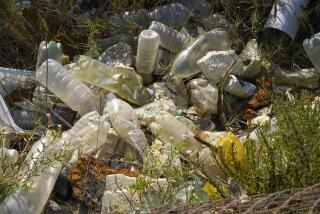EPA Announces New Landfill Regulations
WASHINGTON — Facing a federal court order and an incipient waste disposal crisis, the Bush Administration announced new rules Wednesday that will require municipal landfills to monitor ground-water pollution and impose firm federal standards on new disposal sites.
The plan, a compromise between the Environmental Protection Agency and White House officials who had blocked an earlier EPA proposal on grounds that it was too expensive, will go into effect in two years.
EPA Administrator William K. Reilly, who announced the 250-page regulation, used the occasion to cite progress in recycling massive amounts of paper, aluminum and plastics. But he warned that much of the nearly 200 million tons of municipal trash produced in the United States each year will continue to go into landfills.
“Despite recent advances in recycling and incineration,” he said, “landfills will continue to be the only means of disposal for many communities for years to come.”
Although recycling of municipal waste increased by one-third between 1985 and 1988, nearly two-thirds of cities’ trash and garbage still goes into landfills.
Most of the 6,000 disposal sites now in operation are “simply not environmentally acceptable,” Reilly said. About 3,000 are expected to be closed over the next five years, and EPA officials say that cities increasingly will rely on a smaller number of big regional disposal sites.
Only about 25% of existing landfills already are monitored for contamination of ground water, the source of a significant part of the drinking water consumed by Americans, Reilly said.
The new standards announced Wednesday will require virtually all landfills to monitor adjacent ground water for the presence of 45 organic chemicals and 25 metals that could be leached from the municipal garbage.
The rules will also require new and expanded landfills to use liners made of flexible materials in addition to clay barriers, to install pipes to collect water that leaches through the trash, to clean up any ground-water contamination and to continue environmental management of the sites for 30 years after their closure.
When it first proposed its comprehensive landfill regulations last year, the EPA estimated that compliance would cost $600 million to $1 billion annually. White House budget officials recoiled at the economic impact, and ensuing negotiations dragged on for months.
The delay provoked a lawsuit by the Natural Resources Defense Council, the Sierra Club and other environmental organizations to force completion of the standards mandated by Congress in 1988. A federal judge had ordered the EPA to issue the proposed new rules by Wednesday.
EPA officials estimated that the new regulations will cost $330 million a year. Reilly attributed the dramatic reduction to a more careful accounting of what states have already done to modernize their landfills. Twenty-five states, including California, already have plans that are expected to meet the new federal standards.
Reilly suggested that, besides protecting ground-water supplies, the requirements will help ease tensions over the location of new landfills by encouraging development of larger and fewer disposal facilities.
A Sierra Club landfill expert immediately criticized the regulations as being “riddled with loopholes”--allowing exemption of some landfills that deserve close regulation and failing to require leak detection systems that would prevent ground-water contamination.
More to Read
Get the L.A. Times Politics newsletter
Deeply reported insights into legislation, politics and policy from Sacramento, Washington and beyond. In your inbox three times per week.
You may occasionally receive promotional content from the Los Angeles Times.










